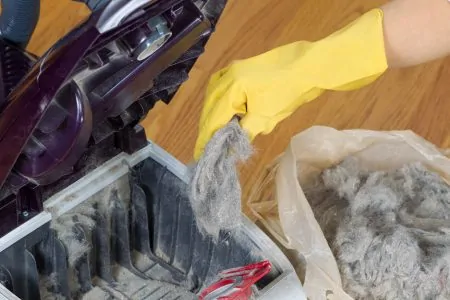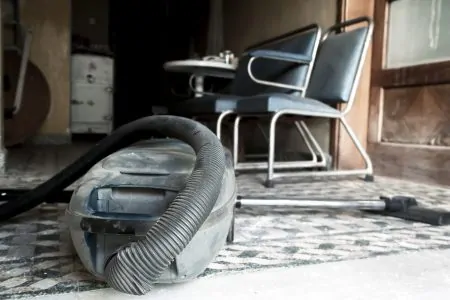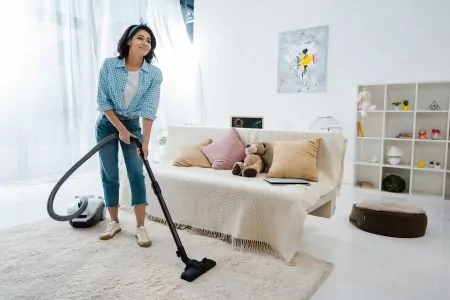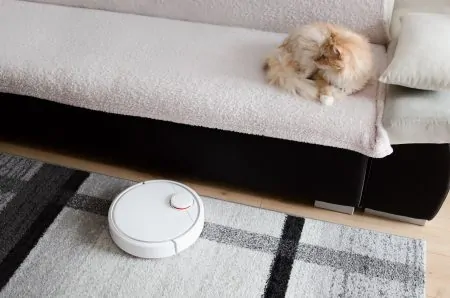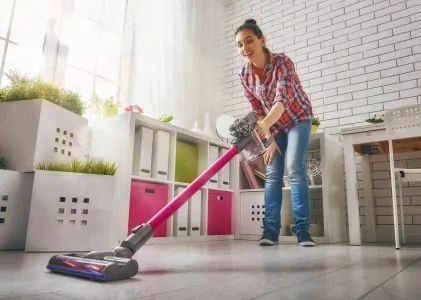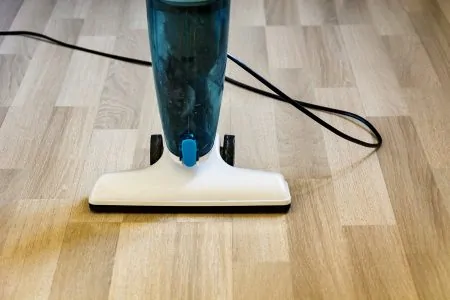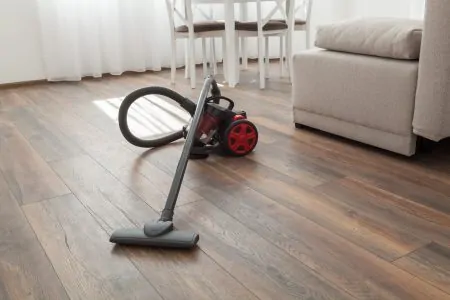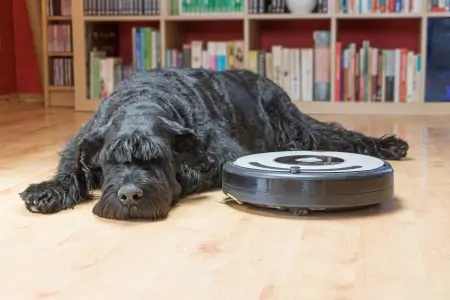Did you notice an odd smell coming from your vacuum? The unpleasant odors can cause concern, making you want to vacuum even less. Then you’re stuck with a stinky vacuum and a dirty home.
Vacuum cleaners need some regular maintenance to prevent dirt build-up. Luckily, a stinky vacuum can smell fresh again with our five tips.
Keep reading to learn how to eliminate vacuum cleaner smells so your whole home feels welcoming.
Key Takeaways
- Unpleasant vacuum smells can be caused by pet hair, mold accumulation, burnt belts, or excessive dust.
- To remove bad smells, empty and clean the dust bag or bin, clean or replace filters, check and clean brushes, and wash the hose.
- Prevent bad odors by using baking soda, essential oils, cinnamon, or commercial deodorants in your vacuum.
- Regular cleaning maintenance every three to six months can help keep your vacuum fresh and your home welcoming.
Why Does My Vacuum Smell Bad?
Understanding where it comes from is critical to better remove and prevent a foul smell. Here are the four leading causes.
1. Pet Hair
Believe it or not, your pet might be responsible for the bad smell. Pet hair and dander smell bad, and when you vacuum, the odors get inside your device.
Pet urine can also add an extra stench. Although you’re unlikely to vacuum your pet urine directly, the liquid can stick to pet hair and dust. Then, once vacuumed, the combination of dried urine and pet hair creates a recipe for musty smells.
2. Mold Accumulation
If you don’t own a pet, you’re unfortunately not exempt from smelly vacuums.
Mold particles can be found in vacuum bags and filters (1). Left unattended, this leads to foul odors.
Mold needs humidity and moisture to grow (2). Vacuuming a wet carpet could bring these particles inside your device, taking the smell to the next level.
3. Burnt Belt
Your vacuum belt can also be the root cause. The belt is made of rubber, and its rotation allows the brush to roll, capturing hair and other dirt.
Vacuum brushes should be cleaned regularly. Without proper maintenance, hair stuck within the bristles may prevent the brush from rotating correctly, damaging the rubber. The belt can also get caught on the brush as well.
Stretched and overused belts produce an easily recognizable, burning plastic smell.
4. Excessive Dust
Dust never comes alone. When you’re vacuuming, other pieces of debris join the ride. So, whether you’re catching dried food or used coffee grinds, they all can contribute to a strong-smelling vacuum.
Letting too much dust accumulate in your dust bag or dust bin will eventually impact the health of your vacuum.
How to Remove Bad Vacuum Cleaner Smells
Have you located the origin of the bad smell? Here are the easiest and most efficient steps to clear your device.
- Time: 30 minutes
- Difficulty: 25 minutes
What You’ll Need
- Replacement dust bags (optional)
- Garbage can
- Water
- Soap
- Cloths
- White vinegar or baking soda
- Replacement filters (optional)
- Scissors
- Long-handled tool, like a broom
- Bleach (optional)
1. Empty Dust Bag or Bin
If your vacuum comes with a dust bag, replace it first. Sometimes, this is enough to get your device’s smell back on the right track.
If your device comes with a dust bin instead, remove it. Empty its contents into your garbage and wash it thoroughly using a cloth dampened with cool water and soap.
We recommend adding a small amount of white vinegar or baking soda to kill potential mildew (3). Ensure that you wash every corner and angle.
2. Clean or Replace Filters
Over time, filters also get dirty and dusty. If your filter is washable, remove the dust around it and rinse it under cold water. Rinse the filter until the water runs clear.
Even clean-looking filters can gather an impressive amount of dust. So, don’t be surprised if this process takes at least five minutes. Then air-dry the filter for 24 hours before placing it back.
If the filter isn’t washable, it might be time to replace it. Generally speaking, you should replace vacuum filters at least once every 12 months. For heavy use, or if you own pets, check the filters every six months
3. Check the Brushes
Regardless of the type of smell, you should clean the rotating brushes at least once or twice a year. Often used to clean carpets and rugs, they can amass a large amount of residue on their own. So, having a quick look under your floor head attachment might be helpful.
- Ensure your vacuum is unplugged.
- If the brush is removable, detach it from the floor head attachment.
- Using scissors, carefully cut and remove any hair stuck within the bristles. Be careful not to cut the bristles themselves.
- Wash the brush with water and soap. If it isn’t removable and is difficult to reach, spray with water and vinegar.
- Air-dry the brush for 24 hours.
- Place it back only when fully dried.
4. Wash the Hose
It’s easy to underestimate the power of the hose when it comes to smelly devices. The hose is one of the first places dirt passes through before reaching the filter, dust bag, or bin.
Small particles often get stuck within the tube’s inner layer, so hoses are also likely to get clogged. Over time they can decay and create a strong odor. Thankfully, however, cleaning a vacuum hose is a reasonably straightforward process.
- Detach the hose and place it on a flat surface.
- To remove any remnants, use a broomstick or other tool with a similar shape. Push through until the blockage is released. You might even get a lost sock back.
- Pour about 4 inches of hot water into your sink.
- Add two tablespoons of bleach and one tablespoon of regular dish soap. Instead of bleach, you can also use baking soda or vinegar.
- Place the hose in the sink. They’re often flexible and should fit most sinks.
- Move the tube around to make sure the water fully runs through and over the entire portion of the tube.
- Empty the sink and place the hose under the tap until the water comes through from the other end.
- Before placing it back, you should fully dry the hose. We recommend hanging it for 24 to 48 hours over a shower curtain or in a well-aerated area.
How to Prevent Bad Odors
Now that we have a clean vacuum, how can we give it a fresh smell?
You should always check with the manufacturer if these methods are allowed. Misusing them could void your warranty.
1. Baking Soda
Baking soda is an old but well-known remedy, famous for its cleaning properties (4). This powdery substance will absorb any unpleasant smells.
Through the hole of the dust bag, sprinkle a few teaspoons inside. If your device comes with a bin, simply sprinkle it over the bin’s walls.
2. Essential Oils
For extra benefit, we recommend adding essential oils. Lemongrass or thyme are known for being beneficial. They not only make your vacuum smell amazing, but they’re also great at fighting mold (5).
Add about 30 drops of essential oils to a 32-ounce spray bottle. Fill it with water and a teaspoon of baking soda. Gently spray inside the bag or bin. We don’t want to dampen the area too much, so a few squirts will do and should dry quickly.
3. Cinnamon
If you’d like to use a spice from your kitchen, cinnamon might be a good idea. Place half of a tablespoon of powdered cinnamon inside the dust bag or bin.
Cinnamon is antibacterial and could reduce the growth of unwanted germs (6). As a bonus, it will add a pleasant aroma to your vacuum.
4. Commercial Deodorants
Although commercial deodorants represent a more significant investment than home remedies, many enjoy their efficiency. They release a pleasant fragrance when the air passes through.
They usually come in various scents so that you can pick your favorite one.
One tablet, or tablespoon, per bag or bin, should be enough.
5. Regular Cleaning Maintenance
Whether you’re sprinkling baking soda or adding a commercial deodorant, cleaning your vacuum shouldn’t be optional.
Regular maintenance is the most effective method to prevent unpleasant smells. Depending on how often you use your vacuum, we recommend cleaning it thoroughly every three to six months. If you own a pet, you might even want to clean it every other month.
FAQs
Conclusion
Used regularly, most vacuums will produce some unpleasant odor. Investigating where this smell comes from is critical to remove it efficiently. Once you’ve localized the issue, you’ll know where to focus your attention.
When a foul odor is identified, you’ll first need to clean and neutralize the odor. Only then will you be able to use a home or commercial remedy to induce a fresh and pleasing fragrance.
We hope these tricks will help you keep your vacuum healthy and fresh-smelling. In turn, your home will also be a more inviting space.
